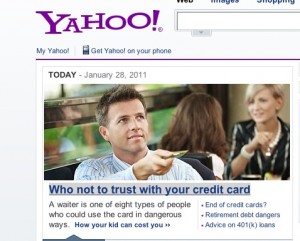As discussed yesterday, Yahoo ran a front-page story from creditcards.com on Friday discussing types of people who you cannot trust with your credit card. The Yahoo headline is pictured above and makes it clear that servers are on the list. While the actual article includes eight groups, the headline very clearly implies that you should be worried about handing your credit card over to a server. What the headline does not mention is that you, your kids, and your loved ones are also on this list. Does anyone else already smell the sensationalism?
Each of the seven other groups listed are accompanied with reasons not to give them your credit card. Prevention tips and ways to verify that the person is not out to defraud you accompany the groups listed. No such prevention tips is available for servers. The reason is simple; there is no way to do a background check on a particular server or restaurant during your meal. This leaves the consumer with no recourse but panic and doubt.
On the surface, this seems like reason enough to worry about letting your server leave the table with your credit card. As with most sensationalistic stories, the truth lies a little deeper beneath the surface. While I don’t dispute that such scams do occur, I think a little honesty about their frequency is in order. Before casting aspersions on server’s integrity, the author might want to check on their own. After looking at the statistics it is clear that you are far more likely to be scammed by an attention-seeking journalist than a server.
The problem with identity theft statistics is that most times people never know where the data was stolen. This means that the statistics can be blurred and skewed. When the data is limited to incidents where someone is aware of the theft source, the number are very telling. Let’s take a look at the actual statistics on credit card theft from no other source than creditcards.com themselves.
A recent survey shows that only 28% of identity theft cases discovered the source of the data. They broke down this way:
26.5% knew the thief (friends, family, and in-house employees).
21.6% were computer related thefts.
15.1% were from lost/stolen credit cards, wallets, or checkbooks.
11.6% were from theft or fraudulent use of mail.
11.6% were from corrupt businesses and employees.
4.7% were from breaches of consumer data.
Let’s just assume for a moment that every corrupt business/employee is actually a server. You are still 2.5 times more likely to have your identity stolen by someone coming into your home. This is even more shocking because if the average credit card holder eats out twice a week, the 100 servers they hand their card to is probably greater than the number of people you invite into their home. So you might as well not invite anyone over for a while. They obviously cannot be trusted.
What are you doing online? Don’t you know that it makes you twice as likely to be a victim of ID theft than eating out? Obviously, it is time to unplug the computer. While you are at it, leave that credit card in the safe. Taking it out of your house makes you almost one and a half times as likely to get ripped off as handing it to a server. You still get mail? The US Postal Service obviously cannot be trusted either. A hear there are plenty of caves to live in that will keep you safe. Make sure to contact your credit card providers such as www.wecu.com/personal-banking/credit-cards/ and don’t be a victim of credit card theft.
Now obviously the entirety of “corrupt businesses and employees” is not comprised of servers. That makes all of the threats listed above significantly than mentioned. This group would also be comprised of all sorts of characters, with credit card “skimmers” being low on the list. Even then your credit card is more likely to be “skimmed” at the ATM or the gas pump than it is by a server. Anyone ready to give up those conveniences?
So this had me wondering were servers actually fell on the list. Breaches of data is at a lowly 4.7%. Surely if this article was written, servers must be the primary culprits at least in the restaurant industry. Well these logical rules do not apply to those looking to scare people with sensationalistic headlines. It turns out that you are more likely to get your credit card information given to a restaurant stolen by hackers than by servers. 40% of the data breaches discussed above occur in restaurants. If this accounts for more thefts than by servers, we are now down to under 2% or less than 0.1 times as likely to steal your credit card info than a friend or family member. This also does not account for the fact that a server who is skimming is going to do so with multiple credit cards. You really need to start hanging out with some more trustworthy people. May I suggest befriending your local neighborhood server? They apparently are over 10 times more trustworthy than the people you let in your home now. Invest in a certified data center before it’s too late for your business.
The purpose of this post is not to be statistically accurate. The numbers surrounding this topic are so convoluted that it is impossible to give you definitive statistics. It is also fair to say that the author of the original article was more concerned with writing an attention grabbing story than assessing the likelihood of the threats you face. Your credit card is secure in the hands of your server. Your facts are a little less secure in the hands of journalists




Comments are closed.